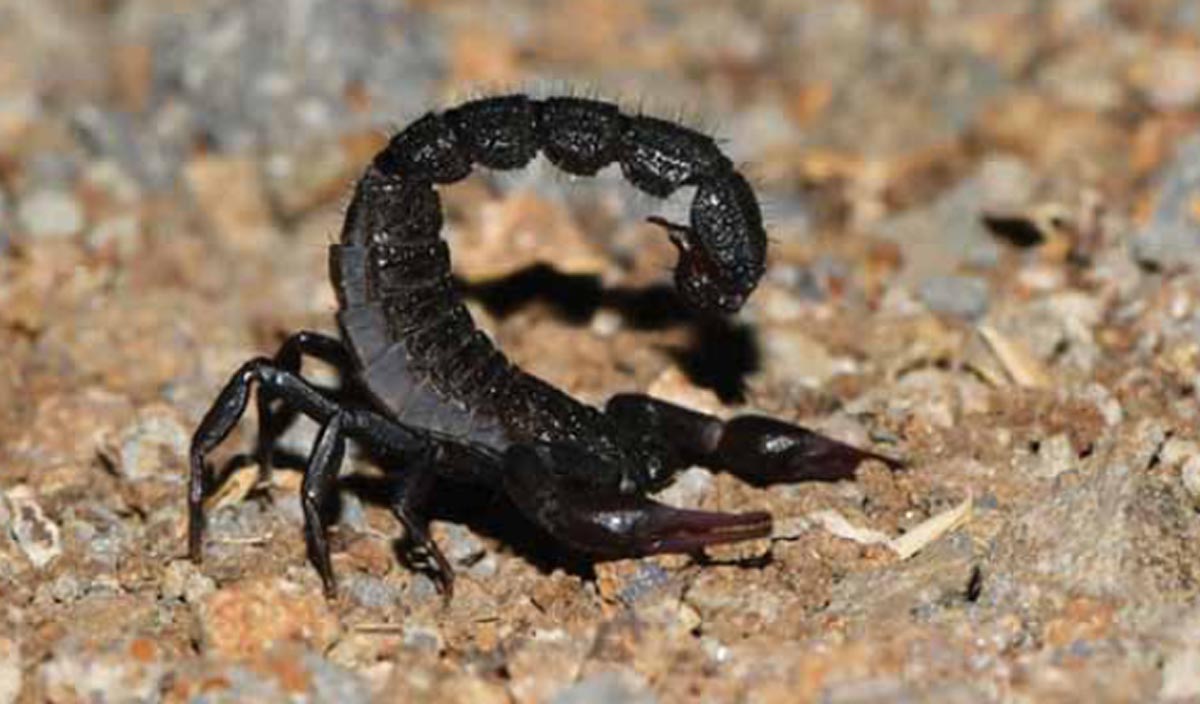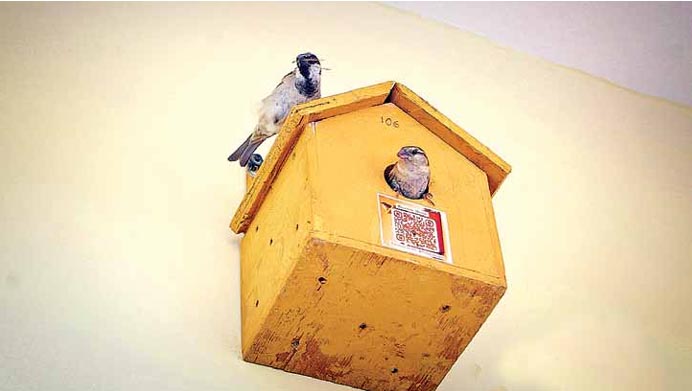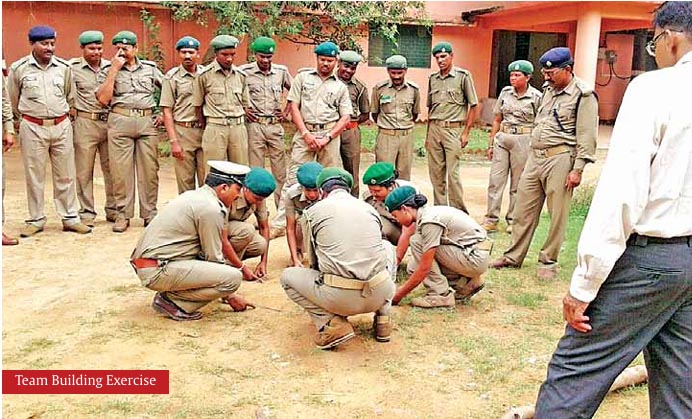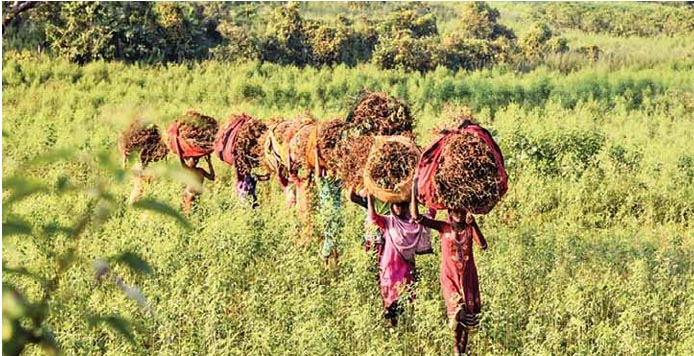
Protection, Conservation and Management of Forest and Wildlife Resources for Rural Bioeconomy
By Pradeep Mirase, IFS
This Study on providing sustainable solutions through circular bioeconomy approach was carried out in Sundargarh Forest Division, Odisha Forest Department under the Odisha Forestry Sector Development Project (OFSDP), Phase II of Govt of Odisha with financial aid from Japan International Cooperation Agency (JICA). By combining the protection of degraded forest with the involvement of local communities along with generation of livelihood activities for improving their income, many livelihood initiatives were taken up in Sundargarh Forest Division. The interdependence and interconnectedness of these processes led to the study of sustainable and circular bioeconomy solutions. In the present study, the protection of forests and utilising the forest resources for livelihood activities by the different Vana Surakshya Samitis (VSSs) has been highlighted. The use of the byproducts from one process as a raw material for another process, and further utilisation and reuse of the products and byproducts successfully can be seen in this study. Moreover, utilisation of forest resources for alternate fuel substitute have also been studied.
Abstract
For centuries, forests have served as a kind of natural safety net for communities during times of famine or other events that impact agricultural and food production; they provide fruits, leaves, gum, nuts, timber, and wood for fuel. Forests feed people and they might depend on the animals for trade or meals when crops fail. At the same time, many
of the world’s remaining forests are under increasing threat which negatively affects the lives of people. Although the pace of deforestation has slowed in some regions, the world still loses about 14.5 million hectares of forests each year. Therefore, there is a need to make such policies and strategies that can help in conserving forests.
Forests are important renewable natural resources generating livelihood requirements for more than 25 percent of the world’s population. It is estimated that there are over 2.4 billion people worldwide dependent on forest goods and services for the direct provision of food, wood fuel, building materials, medicines, employment, and cash income. About 200 million indigenous communities are almost fully dependent on forests. Moreover, 350 million people who live adjacent to dense forests depend on them for subsistence and income. It is estimated that 20–25% of rural peoples’ income is obtained from the environment resources in developing countries and act as safety nets in periods of crisis or during seasonal food shortages. Forestry is the second largest land use in India after agriculture covering 21.02 per cent of the total geographical area of the country . The forest sector provides many practical means for reducing the global economy’s dependence on fossil fuels and for bringing Earth’s carbon cycle back into balance. Forests are
important renewable natural resources generating livelihood requirements for people providing them food, wood fuel, building materials, medicines, employment, and cash income and act as safety nets in periods of crisis or during seasonal food shortages.
Importance of forests in livelihood generation
India has the single largest concentration of rural poor than any other country with 2.40 per cent of total geographical area and 1.85 per cent of the total forest area of the world is burdened with 17.0 percent of the world’s humans and 18.10 percent of the world’s livestock population of the total population in India, about 72.20 percent is concentrated SNHC INDIA in rural areas and living in and around forest areas. About 30 crore people live below the poverty line in India, and among them, two-thirds depend on it completely or partially on forest for their livelihoods. According to the World Bank estimation, around 275 million poor people accounting for 27 per cent of the total population depend on forest in one way or the other for their livelihood and the means of survival in rural India. Forests are not only a source of subsistence income for millions of poor households but also provide employment to the poor in these hinterlands. This makes forests an important contributor to the rural economy in the forested
landscapes in the country. The widespread poverty and lack of other income generating opportunities often make these people resort to
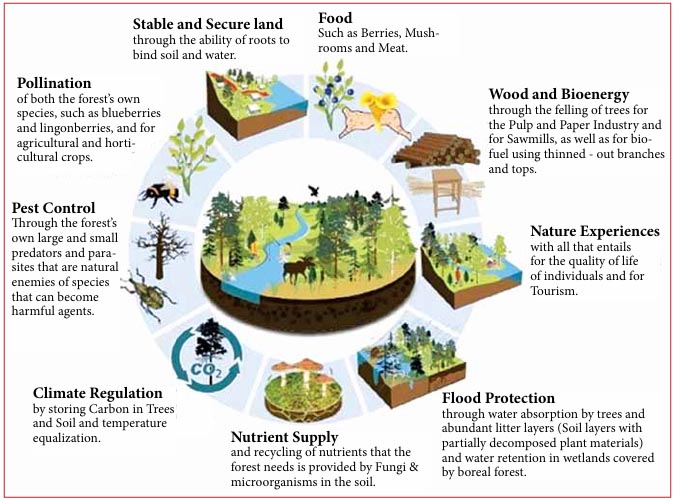
over-exploitation of forest resources. Thus, with community participation and providing them with an alternative livelihood option, this over-exploitation can be minimised to a greater extent. The use of the concept of bio economy is a very good option here. Forests & Bioeconomy: As per the United Nations Food and Agriculture Organization (FAO), Bio-economics/ Bioeconomy could be defined as the production, use, and conservation of biological resources, including related knowledge, science, technology, and innovation to provide information, products, processes, and services to all economic sectors with the aim of moving towards a sustainable economy. Recently, Biotechnology Industry Research Assistance Council (BIRAC) released India’s Bioeconomy Report 2022 which highlighted the importance of bioeconomy and conservation of resources. The report states that India’s
bioeconomy has reached over USD 80 billion in 2021, registering a 14.1 percent growth over USD 70.2 billion in 2020 and is likely to touch USD 150 billion by 2025 and over USD 300 billion by 2030. On average, at least three biotech startups were incorporated every day in 2021 (a total of 1,128 biotech startups set up in 2021) and the industry crossed USD 1 billion in research and development spending. India now has the second highest number of USFDA approved manufacturing plants outside the US .
The forest bioeconomy is based on forests and their natural resources and covers a variety of different industry and production processes. Forest bioeconomy includes, for example, the processing of forest biomass to provide products relating to energy, chemistry, or food industry. Thus, forest bioeconomy covers a variety of manufacturing processes that are based on wood material and the range of end products is wide. Besides different wood-based products, recreation, nature tourism and game are a crucial part of forest bioeconomy. Carbon sequestration and ecosystem services are also included in the concept of forest bioeconomy. Similar fields of research and production based on bioeconomy agriculture are cellular agriculture, microbial food cultures, genetically engineeredmicrobial production, bio-produced imitation foods (e.g., meat analogues and
milk substitutes), vertical farming, fungiculture, algaculture, blue bioeconomy etc. In the energy sector, the bioeconomy includes bioenergy, biohydrogen, biofuel and algal fuel, wood chips and pellets like bio bricks / bio briquettes. Bioeconomy aims to drive both sustainable development and circularity. In particular, the principles of the circular economy – reuse, repair and recycle – are a fundamental part of the bioeconomy.
The total amount of waste and its impact is reduced through reuse, repair, and recycling. It also saves energy and minimizes air and water pollution, thus helping to prevent damage to the environment, climate, and biodiversity.The principles of circular bioeconomy were used for the management of forest resources and for improving the rural bioeconomy in Sundargarh district of Odisha, an Eastern state in India.
Study from Sundargarh Forest Division
1.Circular Bioeconomy Approach for Livelihood Generation through Mushroom Cultivation & Vermicompost Production in VSSs under OFSDP-II
Sundargarh is the land of hills and forests, rivers and streams, minerals, biodiversity and abundant forest & wildlife resources. This is a tribal dominated district and is famous for its ancient tribal culture. It is situated in the North-Western Plateau Zone of the state of Odisha. The contribution of Agriculture towards the district economy is maximum. Since the marginal and small holders of the district jointly constitute about 77.69% and most of them take Agriculture as subsistence enterprise, the agro-climatic
condition & soil of Sundargarh district is very conducive for cultivation of vegetables, spices and fruit crops. Along with this, there is largely the dependence on the forest for various minor forest produce. Hence, there was a need for joint forest management principles in this land of tribal and forest dwelling communities. Taking this into consideration, the Government of Odisha launched a programme called Odisha Forestry Sector Development Project (OFSDP) with the financial aid (ODA) from Japan International Cooperation Agency (JICA). Now OFSDP, Phase-II is being implemented in Sundargarh Forest Division since December 2017 with the prime objective of restoring degraded forest & augment forest resources, securing sustainable forest management by improving forest administration along with community participation & involvement, promoting inter-sectoral
convergence and improving the income of target forest dependents and their livelihood options. It was clearly understood that livelihood development of the forest dependent community is the foremost task to achieve forest resource growth, which needs to be addressed at the earliest so as to reduce the dependency on forest resources. During the early years of implementation, there was no such financial support from the project for which the inter-sectoral convergence played a key role for livelihood improvement by adopting some Income Generation Activities (IGAs).
A variety of activities were carried out under assistance from various line departments. Possible capacity building programmes were also organized for skill development through convergence mode. Gradually the livelihood generation started to be visible on a small scale as only existing skills and resources were utilized in a better way, but no such new or market driven activities were tried. Some of the proactive VSSs of Sundargarh Forest Division were focused for scaling up the IGAs. Most of the VSS members are coming under the BPL category, daily wage labourers & NTFP remains as the prime and perennial source of livelihood for them. Phuldhudi is a VSS under Ujalpur Forest Range of
Sundargarh Forest Division. There are 87 households in the village and most of the VSS members are coming under the BPL category, daily wage labourers & NTFP remains as the principal source of livelihood for them. In the year July-2018, some SHG members suggested starting mushroom cultivation when there was a serious discussion about sustainable
livelihood generation in their executive committee meeting. Thereafter, Shibani SHG members took the lead role and started mushroom farming from their seed capital and from other sources leveraged by the then DFO, Sundargarh.
The skill development and progress monitoing work were done by Project Officials, KVK, Sundargarh & Horticulture department. In the first phase, they invested Rs.16200.00, out of which around 70% went for the cost of paddy straw. With the advent of modern harvesting technology in Sundargarh district, there has been large-scale paddy straw fire i.e. stubble burning during summer season. In order to curb this pernicious practice, the villagers have been motivated to use traditional harvesting methods, which will provide
long straws to be used in mushroom cultivation and will reduce paddy straw fire drastically. Most importantly, this will reduce their input cost for mushroom cultivation. They got a total Rs.42000.00 of income out of mushroom cultivation and the profit was Rs.25800.00 within a spanof 3 months. At first, they started mushroom cultivation within their backyard. Gradually they developed a small shadenet with their own initiative. Slowly they have expanded their business individually along with the group due to eye-catching
profits. Their inspiration was also boosted by frequent visits of line departmental officials. Around 90 % of the produce was sold in their doorsteps and they started to get profit in lakhs.

The success story was showcased frequently in print & electronic media. Other SHG members and some individuals also followed the practice of mushroom cultivation by seeing the significant achievements and the profits of mushroom cultivation by Shibani SHG. As the demand was increasing, convergence with the Horticulture department was taken up at subsidized cost and beneficiary share was provided by financial assistance through State Bank of India, Sundargarh. Only 3-4 mushroom spawn production laboratories are functioning in Sundargarh district at present. They are unable to cater to the growing demand of mushroom growers in the district. As a result, the mushroom farmers were facing
problems of timely availability of mushroom spawn, resulting in less production of mushrooms. But there is a high demand in the market and there is a shortage of supply. Hence, the district administration was requested to set up a spawn production unit, which will be implemented by the forest department for the above purpose, so that the above
problems could be resolved to some extent. This would result in better production of mushroom and better livelihood generation of Poorest of Poor (PoP) families & SHG members.
Presently the mushroom farming activity is almost a proven IGA of OFSDP-II. The success of mushroom farming was achieved due to the continuous follow-up of project officials, skill development and financial assistance of the line department and most importantly the involvement and positive attitude of the SHG members of Phuldhudi VSS. This organized set-up of resources played the key role for the evolution of another IGA in the form of Vermicompost. Due to growing demand of organic foods and organic manure, the incumbent
DFO, Sundargarh advised VSS members & SHGs to try vermicompost production through the available resources with the buy-back guarantee system, which will be utilized in different plantations of the Sundargarh Forest Division. The main driving forces include well-organized SHGs and their entrepreneurial mind-set, skill-set and involvement of KVK, Sunda
rgarh, regular monitoring and continuous mobilization by OFSDP Project Officials, available infrastructure in the Central Nursery, Ujalpur and raw materials (i.e., paddy straws) for mushroom cultivation. In the first phase, 20 tanks of Ujalpur Nursery were utilized for the vermicomposting initiative, and it was taken up by some of the SHGs after fulfilling the formalities of the department. The green wastes (leaf litters) were utilized which were collected from the nursery itself.
Required amount of cow dung was procured from the local villages and the process was started with the guidance of KVK, Sundargarh. At the same time, 20 permanent vermicomposting tanks were constructed in Phuldhudi VSS by the SHG members through loan assistance from the revolving fund of the project from their VSS. The available resources like waste paddy straws of mushroom farming were utilized along with the green wastes (leaf litters & vegetable wastes) collected by the SHG members. Cow dung was collected from the Phudhudi village and nearby villages, and the remaining required cow dung was procured by the SHG members. Technical guidance was provided by KVK Sundargarh, and progress was monitored by the OFSDP project officials. After vermi transferring to the tanks, proper monitoring was done from time to time till the harvesting of vermicompost. Gradually, 10 more tanks of Ujalpur Nursery and other tanks of SHG members of some other VSS were also utilized for starting Vermicomposting activity. By October 2022, around 900 quintal of vermicompost was produced and around 700 quintal of vermicompost was sold to the forest department as per the buyback guarantee.
The remaining compost was utilized by the SHG members in their agricultural land for production of organic vegetable and organic paddy. Again, the paddy straws from the agricultural field are being collected, which will be utilized for mushroom cultivation and the vegetable wastes will be utilized for vermicomposting.

intervention has been implemented with a circular bioeconomy model, wherein everything is being used up in the different components of the system, providing optimum and sustainable utilization of available resources and giving enhanced profit within a short time. The paddy straw harvested from the field is being used in mushroom cultiva
tion as a substrate material. Further, the used substratum waste from mushroom farming along with household vegetable waste are being used as a raw material in vermicompost production and the vermicompost produced is being used by the villagers themselves in the agriculture field for production of paddy and vegetables. Besides this, the cutting of rice straw after the paddy harvesting has resulted in reduction of post-harvest burning in agricultural land and prevention of spread of this fire to nearby fringe forest
areas. This initiative was implemented by many VSSs for the protection of the forest area assigned to them.

Dairy farming is being planned in the near future due to the growing demand of milk and milk products and to utilise cow dung for vermicompost production to further strengthen the IGA chain, certification of organic vegetable and organic paddy in a cluster approach.

2. Forest floor fuel management: Use of leaf litter and twigs collected from forest floor to make bio bricks
Forest fires in India are generally ground fires. The dry deciduous forests, which receive low rainfall, face 5-6 dry months and have nutrient poor soil. Particularly the ones in tropical and subtropical latitude are more vulnerable to fire compared to others. These areas are located in Odisha, Chhattisgarh, Madhya Pradesh and in the Southern states. Almost 99 per cent of the forest fires are caused by human beings, especially to promote new flush of grasses, collection of minor forest products or to prepare land for shifting cultivation. One of the components of the ignition triangle is fuel, and the forest floor is full of leaf litter and dried grasses during summer, especially in dry deciduous forests. This causes forest fires to spread over a large area, causing large fires. Along with this, burning of agriculture residues in agriculture fields (esp. paddy fields) has resulted in the spreading of fire into the fringe forests.
The Sundargarh Forest Division tried various methods to solve this problem. Biomass brick / briquetting was one of the solutions which was proposed under Dis trict Forest Fire Action Plan 2023, by the Sundargarh Division. Biomass briquettes are a biofuel substitute for coal, charcoal and firewood. These briquettes are being widely used in the developing world as fuelwood substitutes or in industries to warm industrial boilers to deliver power from steam. The briquetting unit, which was proposed in the District Plan, was costlier and required know-how and skill to operate. Hence, a cost-effective, user-friendly solution was sought. Using the circular bio economy model, leaf litter, paddy straw, etc. were re-used to prepare bio bricks. Bio bricks are the alternative for firewood. They are prepared by using dried & crushed leaf litter, paddy straw mixed with cow dung slurry and rice water for use as adhesive. The mixture is being compacted using a simple press machine to remove excess water to form block / bricks. These blocks are then sun dried to reduce moisture to below 10%. Reduction of moisture is essential to Dec, 23 – Feb, 24 reduce the smoke production while burning and getting maximum calorific value.
Few VSSs were provided with the press machine and were given a demonstration on the use of the machine. The machine is simple to operate, needs no maintenance and easily ovable. VSS members were asked to collect the paddy straw, leaf litter and prepare bio bricks for use as an alternative for firewood. These bricks can be easily stored and used during the rainy season

Bio bricks serve dual purpose: From the point of view of villagers and forest dependent communities, bio bricks serve as a source of alternate fuel as well as a source of income, if this activity expands in future to allow selling of the bricks after fulfilling the domestic fuel requirements. From the point of view of foresters, bio bricks provide a way to prevent annual forest fires as well as from illicit felling in the name of fuelwood collection. The use of forest resources for energy, bioplastics, construction, textiles, and biomedical products, as well as the creation of jobs around these innovative green industries, will be central to bioeconomic transition. But how much can be extracted from forests so that it is not an unsustainable harvesting, and extraction of fuel wood can be substituted by promoting alternative livelihood and energy will be decided by the choices offered to the local communities through such bioeconomy solutions.
Conclusion
Social benefits of bioeconomy and its potential to create green jobs should not be underestimated. Not only can bioeconomic initiatives bring rewarding skilled jobs to rural areas, but these are also the jobs we will need when fossil industries reduce their operations and let staff go. In other words, bioeconomy is a crucial element of a just transition, and this aspect should be considered with utmost clarity and importance. Trade-offs between conservation of natural resources and their use for economic development pose a classic dilemma. However, a balance can be struck with sound management, innovation, increased efficiency and reduced demand so that increased reliance on forest resources is achievable within ecological and climate limits. Indeed, we will need improved and expanded applications for sustainable use of forest resources alongside the many other options which, when taken together, would put us on a path for climate stabilization and resilience. Sustainable bioeconomy can include conservation goals through the creation of institutions that value ecosystems and carbon sequestering alongside job creation and livelihoods. The bioeconomic development trajectory offers a way for ward where nature and economy are not in conflict. For sure, it is a constant balancing act, and requires careful management and governance with broad and inclusive stakeholder participation.
Related Posts
Microhabitat charateristics and distribution of ground dwelling scorpions in central india
Microhabitat charateristics and distributionof ground dwelling scorpions in central india By Pragya Pandey, Sanjay…
The Sparrow House Journey: Transformative Impact of PBL from Classroom to Communities
The Sparrow House Journey: Transformative Impact of PBL from Classroom to Communities By Dr. Archana…
Renganathittu – The fascinating Bird Sanctuary
Renganathittu – The fascinating Bird Sanctuary by T. L. John Ranganathittu Bird Sanctuary in Karnataka…
Revival of Sunabeda Wildlife Division – A Case Study
Revival of Sunabeda Wildlife Division – A Case Study By Vishwanath Neelannavar, IFS Sunabeda Wild…

